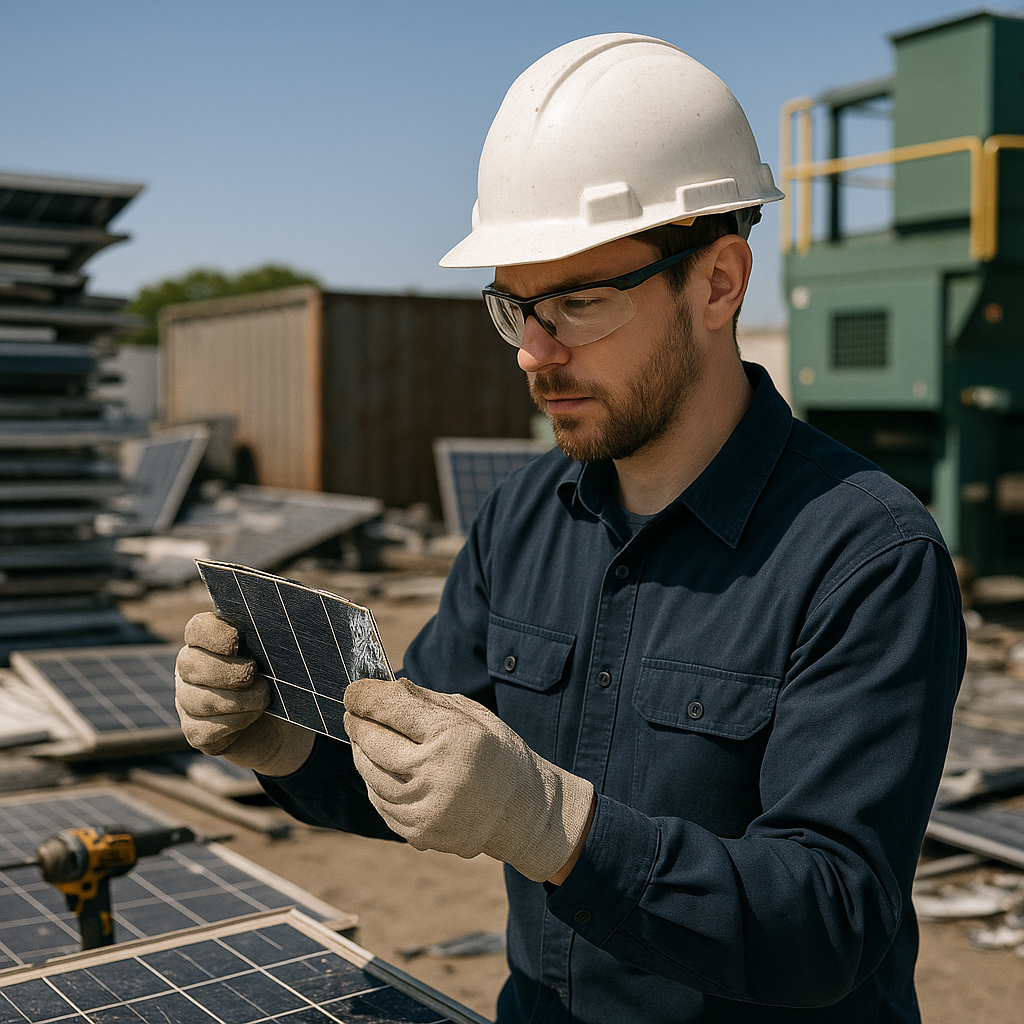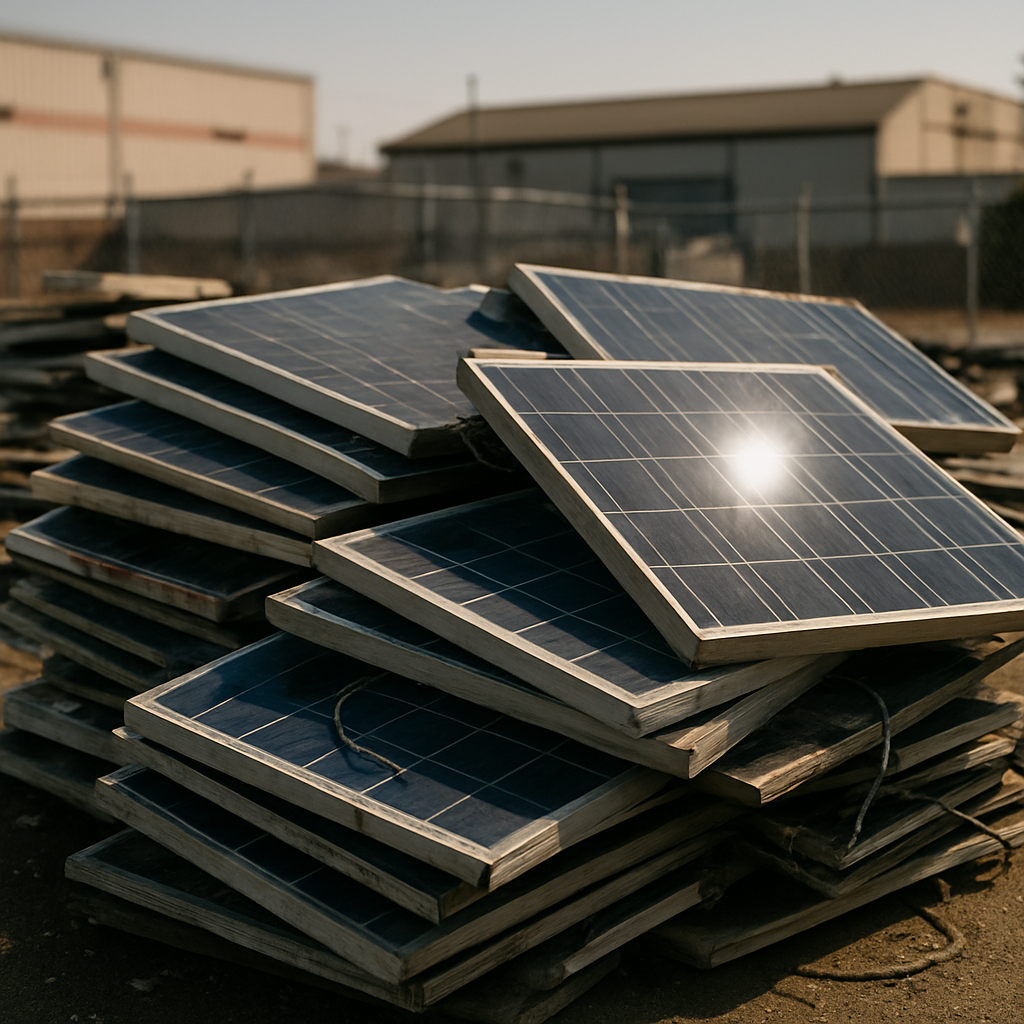5901 Botham Jean Blvd, Dallas, TX 75215
How Are Solar Panels Recycled? A Quick Overview
July 9, 2025By 2050, experts predict we will face 78 million metric tons of solar panel waste worldwide. This daunting figure highlights the urgent need for effective recycling solutions in the renewable energy sector. Solar panels, while providing clean energy during their operational life, eventually reach the end of their useful cycle.
Solar panel recycling is becoming increasingly important as global installations continue to surge. With panels having a typical lifespan of about 30 years, proper recycling processes are crucial to recovering valuable materials and reducing environmental impact. Most panels contain recyclable components, including aluminum frames, glass, silicon cells, and precious metals like silver and copper.
Without proper recycling channels, these materials—many of which are rare, expensive, or potentially hazardous—would end up in landfills. The recycling challenge arises not from the materials themselves, but from separating them efficiently and economically. This article explores the methods, importance, and future of solar panel recycling as we move toward a more circular approach to renewable energy.
What Components of Solar Panels Can Be Recycled?
Solar panels are complex devices comprised of multiple materials. Many of these components can be recovered and reused with proper recycling techniques. A standard solar panel includes several valuable and recyclable materials that can be extracted through specialized processes.
The recyclable components of solar panels include:
- Glass – Comprising about 75% of a panel’s weight, glass is one of the most easily recyclable components. Modern recycling facilities can recover 90-95% of this material for reuse in new products.
- Aluminum framing – The frames surrounding solar panels can be fully removed and recycled through standard aluminum recycling processes, with recovery rates of approximately 95%.
- Copper wiring – The internal wiring that conducts electricity through the panel contains valuable copper that can be extracted and repurposed in various electronics.
- Metal components – Elements like silver contacts and tin can be recovered through specialized processes. Silver is particularly valuable despite being present in small quantities.
- Silicon cells – These semiconductor materials are more challenging to recycle but can be processed through thermal or chemical treatments. Current technologies recover 80-85% of the silicon content from panels.
- Junction box and plastics – The plastic junction box and polymer components can be recycled, though at lower rates (70-80%) than metals and glass.
Not all materials are equally easy to recycle. While aluminum frames and glass can be processed through conventional recycling channels, silicon cells present unique challenges. These cells are typically sealed between glass layers with strong adhesives like ethylene vinyl acetate (EVA). Breaking down these adhesives requires temperatures exceeding 500°C or specialized chemical treatments.
The difficulty in separating these bonded layers makes silicon cells costlier to recycle than other components. However, advanced recycling facilities use mechanical, thermal, and chemical processes to break these bonds and recover the valuable materials. The economic viability of silicon recovery improves as recycling technologies advance and the volume of panels processed increases.
Despite these challenges, modern recycling techniques can potentially recover up to 95% of a solar panel’s materials by weight. This high recovery rate transforms potential waste into valuable resources for manufacturing new products, including new solar panels.
| Glass | 90-100% |
| Aluminum | 100% |
| Silicon | 85-92.4% |
| Silver | 90-98.7% |
| Copper | 90% |
What Are the Main Methods for Recycling Solar Panels?

Solar panel recycling technology has significantly evolved in recent years. The industry employs three primary methods to recover valuable materials from end-of-life panels: mechanical, thermal, and chemical recycling. Each technique plays a crucial role in addressing the growing challenge of solar panel waste management.
Mechanical Recycling
Mechanical recycling represents the initial phase in most solar panel recycling processes. This method involves physically breaking down panels into their component materials without chemical treatments. The process typically begins with manual disassembly to remove aluminum frames, junction boxes, and cables.
Once disassembled, the panels undergo crushing or shredding to separate the various materials. Specialized equipment then sorts these materials using techniques like eddy current separation for metals and vibration screening for glass. This process can recover about 85% of a panel’s weight in recyclable materials, primarily aluminum, copper, and glass.
The main advantage of mechanical recycling is its simplicity and lower environmental impact compared to other methods. It requires less specialized equipment and doesn’t involve potentially hazardous chemicals. However, its effectiveness is limited when recovering high-purity silicon and precious metals like silver, which remain embedded in the crushed materials.
Thermal Recycling
Thermal recycling uses controlled heat to separate solar panel components that mechanical processes cannot easily divide. This method is particularly effective for removing the ethylene vinyl acetate (EVA) encapsulant that binds the solar cells to the glass.
In a typical thermal recycling process, panels are heated in specialized furnaces to temperatures ranging from 500°C to 600°C. This heat causes the polymer layers to burn off or evaporate, allowing for the separation of glass, silicon cells, and metal components. The process can recover up to 95% of semiconductor materials when properly executed.
While highly effective for material separation, thermal recycling requires significant energy input. The high temperatures needed also create potential air pollution concerns if emissions aren’t properly filtered. The process works best when combined with mechanical pre-processing and chemical refinement afterward.
Chemical Recycling
Chemical recycling employs various solvents and chemical reactions to dissolve and separate materials at the molecular level. This method is particularly valuable for recovering high-purity semiconductor materials and precious metals that other processes cannot efficiently extract.
The process typically involves treating crushed panel materials with specific chemical solutions. For silicon-based panels, acids like nitric acid may be used to dissolve silver contacts, while other solutions target different components. Companies have developed specialized chemical sequences to extract materials with minimal contamination.
Chemical recycling achieves the highest purity levels for recovered materials. A well-designed chemical process can recover more than 95% of a panel’s silicon and up to 99% of certain metals. The main drawbacks include the cost of chemical inputs, the need for strict environmental controls, and the complex waste management requirements for used solutions.
| Recycling Method | Process Description | Recovery Rate |
|---|---|---|
| Mechanical Recycling | Manual disassembly, followed by crushing or shredding to separate materials. | 85% by weight, mainly aluminum, copper, and glass. |
| Thermal Recycling | Heating panels in furnaces to burn off polymer layers and separate glass, silicon, and metals. | Up to 95% of semiconductor materials. |
| Chemical Recycling | Involves the use of solvents to dissolve and separate materials at the molecular level. | More than 95% of silicon and 99% of certain metals. |
| Integrated Approach | Combines mechanical, thermal, and chemical processes to maximize recovery rates. | More than 90% by weight, including high-purity silicon. |
Integrated Recycling Approaches
Modern solar panel recycling facilities rarely rely on a single method. Most efficient operations combine all three approaches in sequence. Panels first undergo mechanical disassembly and crushing, followed by thermal treatment to remove encapsulants, and finally chemical processing to recover high-value materials.
This integrated approach maximizes material recovery rates while optimizing energy use and chemical consumption. Leading recyclers can now recover more than 90% of a panel’s materials by weight, including high-purity silicon suitable for reuse in new solar products.
As solar installations continue to grow worldwide, these recycling technologies will become increasingly important. Improvements in these processes are helping transform end-of-life solar panels from potential waste into valuable material resources for the circular economy.
Why is Solar Panel Recycling Important?

Solar panel recycling plays a crucial role in sustainable waste management as millions of panels approach the end of their useful life. Without proper recycling, solar panels can occupy valuable landfill space and allow harmful materials to leach into soil and water. By 2050, nearly 78 million metric tons of solar panels will be decommissioned globally.
Recycling prevents toxic substances like cadmium and lead from entering the environment. These materials pose serious environmental risks when improperly disposed of. Properly recycled panels keep these hazards contained while supporting clean energy’s promise of environmental protection.
Conserving valuable materials is another critical benefit. Solar panels contain recoverable elements such as silicon, silver, copper, and aluminum. Silver, vital for solar cell technology, is increasingly scarce. Recycling helps alleviate pressure on limited natural resources and reduces the energy consumption associated with mining raw materials.
The economic value of solar panel recycling cannot be overstated. Experts project that recycling could create approximately £11 billion in recoverable value by 2050. This substantial financial return makes it possible to produce around 2 billion new panels without investing in raw materials. The reclaimed materials could support approximately 630 GW of energy production.
Job creation offers another economic benefit. As the solar industry expands, recycling operations will require skilled workers. These green jobs support both environmental goals and economic growth, particularly in regions that develop recycling infrastructure early.
Recycling supports global sustainability goals by establishing a circular economy within the renewable energy sector. The European Union has set ambitious targets, requiring at least 85% of solar panel materials to be recycled under the Waste Electrical and Electronic Equipment directive. This approach ensures resources remain in use rather than discarded.
Current recycling technology shows impressive efficiency. Advanced processes can recover up to 90% of a panel’s materials. Glass components, which constitute a large portion of panels, can be recovered at rates of 95%. Silicon recovery reaches about 85% using thermal and chemical processes.
The reduction in carbon footprint achieved through recycling further enhances solar energy’s environmental benefits. By reusing materials, emissions associated with mining and processing new resources are decreased, creating a more complete sustainability cycle for solar technology.
Material Recovery and Resource Conservation
Solar panels contain several valuable materials worth recovering. Silicon wafers form the heart of most panels. Though silicon is abundant, refining it requires significant energy. Recycling silicon reduces the need for new extraction and energy-intensive processing.
Glass comprises most of a panel’s weight and can be effectively recycled into new panels or other products. Its high recovery rate makes glass recycling especially important for reducing waste volume.
Metals in solar panels include silver, copper, and aluminum—all essential for conducting electricity. Silver, particularly valuable and increasingly scarce, can be reclaimed through specialized recycling processes. According to the Silver Institute, global demand for silver continues to rise, driven partly by solar industry growth.
Rare elements like indium also appear in certain panel types. These materials face supply constraints and come from politically sensitive regions. Recycling provides a domestic source of these elements, reducing dependency on imports and supporting energy independence.
| Component | Recovery Rate | Notable Facts |
|---|---|---|
| Glass | 90-95% | Composes 75% of solar panel weight |
| Aluminum | 95% | Used in frames |
| Silicon | 85% | Requires thermal or chemical treatments |
| Silver | ~90% | High-value material present in small quantities |
| Copper | 90% | Found in wiring and electrical components |
Economic and Industry Growth Impacts
The solar panel recycling industry is poised for substantial growth. As more panels reach end-of-life, recycling capacity must expand to match. This growth creates business opportunities for recycling companies and supports the broader renewable energy sector.
Recycling can make solar energy more affordable by reducing material costs. As recycled materials enter the supply chain, manufacturers rely less on newly mined resources, stabilizing prices and making solar installations more economically attractive.
Technological improvements continue to enhance recycling efficiency. New processes, like laser-based separation techniques, allow for more precise material recovery without contamination. Chemical processes for silicon recovery have become more energy-efficient, improving the economic viability of recycling operations.
Government policies increasingly support solar panel recycling. The European Union leads with comprehensive regulations, while other regions develop similar frameworks. These policies create market certainty for recycling investments and help establish industry standards.
Industry-led initiatives also advance recycling practices. Some manufacturers now design panels with recycling in mind, facilitating easier material recovery. Take-back programs allow consumers and businesses to return old panels directly to manufacturers for proper recycling.
As solar deployment accelerates globally, recycling becomes essential for sustainable industry growth. Without effective recycling, the environmental benefits of solar energy are partially undermined by waste issues. With proper recycling, solar truly delivers on its promise as a clean energy solution.
What Are the Challenges and Future of Solar Panel Recycling?

Despite the environmental benefits and resource recovery potential, solar panel recycling faces significant hurdles limiting its widespread adoption. The primary challenge is economic viability. Recycling a solar panel costs between $20 and $30, while landfill disposal may only cost $1 to $5 per panel. This stark cost difference discourages recycling, resulting in about 90% of decommissioned panels ending up in landfills rather than recycling facilities.
Economic Challenges
The unfavorable economics extend beyond processing costs. Transportation is another significant expense, with collection costs ranging from $0.05 to $0.25 per watt depending on accessibility. Shipping a single container of 300-500 panels typically costs between $1,000 and $2,000, making recycling economically impractical for many operators, especially smaller ones.
Another economic factor is the value of recovered materials. Currently, the materials from a recycled panel generate only $3 to $8, far below recycling costs. Many recycling facilities require a minimum of 4,000 tons of waste annually to maintain profitability, creating additional barriers for homeowners and small businesses seeking responsible disposal options.
Infrastructure and Logistical Limitations
The lack of widespread recycling infrastructure is a major challenge. In the U.S., recycling options are limited and fragmented, with no comprehensive federal regulations for PV module recovery. This contrasts with the European Union, which implements policies like extended producer responsibility under the Waste Electrical and Electronic Equipment Directive.
Collection systems for end-of-life panels are underdeveloped. As solar installations are spread across wide areas, transporting panels to recycling facilities incurs substantial costs. Many regions lack local recycling options, an urgent issue as solar capacity expands globally.
Technical Challenges
Solar panels are complex composite products designed for durability, not recyclability. Modern panels consist of layers of glass, aluminum, silicon cells, and polymers, bonded with adhesives like ethylene-vinyl acetate that require temperatures above 400°C to break down, making separation energy-intensive.
New panel technologies add recycling complexities. Bifacial panels, capturing sunlight on both sides, require different techniques. Emerging technologies like perovskite solar cells raise concerns with lead content, while tandem cells integrating multiple PV technologies create further recycling challenges.
No table output available
Promising Technological Advancements
Despite challenges, technological innovations are boosting recycling efficiency. Advanced thermal and chemical processes can recover up to 98% of panel materials with high purity. Some researchers have devised methods to extract over 90% of valuable silver within minutes, improving recovery economics.
Emerging technologies like laser-based recycling methods are popular, with a projected growth rate of 9.8% through 2030. These techniques minimize material loss while efficiently recovering valuable components like silver and silicon.
Chemical leaching, robotic disassembly, and advanced material separation techniques show promise for improving recovery rates and reducing costs. Nanotechnology-based recycling and chemical vapor deposition recycling pilots highlight potential for enhancing thin-film material recovery.
Evolving Regulatory Landscape
Regulatory developments are addressing recycling challenges. Washington State mandated manufacturer recycling programs with its Solar Incentives Job Bill in 2017. California classified end-of-life solar panels as universal waste, simplifying management while maintaining environmental protections.
The Environmental Protection Agency is classifying hazardous waste solar panels under universal waste regulations, which could simplify management and save facilities significant costs annually.
In Europe, the EU mandates manufacturers be responsible for the collection, treatment, and recovery costs of their products at end-of-life. This extended producer responsibility is expected to drive solar panel recycling and promote sustainable design.
The Economic Future of Solar Panel Recycling
The economics of solar panel recycling are improving. Industry experts project the value of recycled materials will grow from $170 million to $2.7 billion by 2030. By 2050, this value could reach $15-30 billion, equivalent to raw materials for approximately 60 million new panels.
Companies like SOLARCYCLE are leading ambitious projects, including a Georgia facility designed to process 10 million solar panels annually, a significant step in addressing the expected volume of end-of-life panels by 2030.
Policy changes may further shift the economic landscape. Extended producer responsibility programs require manufacturers to manage product lifecycles, creating financial incentives for proper recycling while discouraging landfill disposal.
As more regions adopt such policies, recycling economics will likely become more favorable, creating green jobs while conserving valuable resources like silicon, glass, and metals. Through continued innovation in recycling methods, the solar industry is advancing toward true sustainability throughout the lifecycle of solar products.
Conclusion: The Circular Future of Solar Energy

Solar panel recycling is crucial for true sustainability in the renewable energy sector. As solar installations globally continue to rise, the need for effective end-of-life management becomes increasingly clear. Without proper recycling, we risk undermining the environmental benefits solar energy provides. Recovering valuable materials like silicon, silver, and aluminum not only diverts waste from landfills but also reduces the demand for new raw materials.
The circular economy approach to solar energy ensures that today’s panels become tomorrow’s resources. As recycling technologies advance and infrastructure improves, the industry moves closer to a closed-loop system where solar power generates clean electricity without the environmental impact of unmanaged waste. This evolution, from focusing solely on energy production to embracing full lifecycle sustainability, represents a significant maturation of renewable energy.
For professional guidance on responsible solar panel disposal and recycling options, contact Okon Recycling at 214-717-4083. Their expertise in solar panel recycling ensures your renewable energy choices remain environmentally sound from installation through end-of-life.
